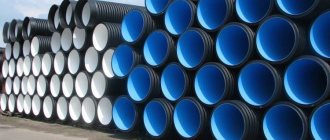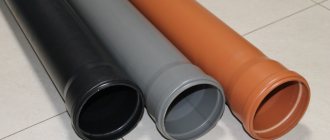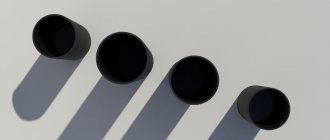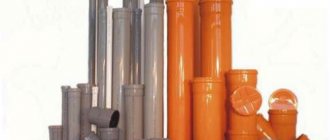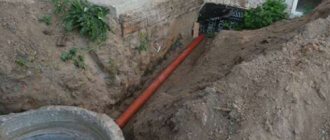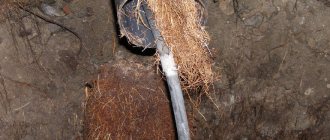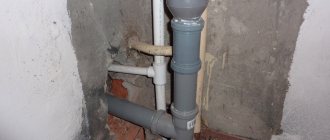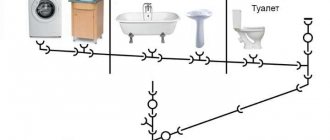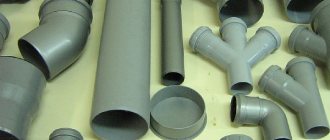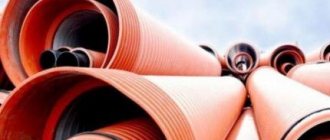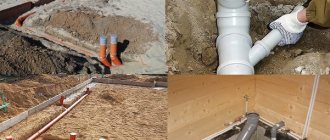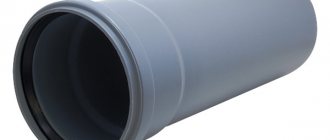A corrugated sewer hose is a product that is made from polymer materials and is used in the installation of sewer systems (both internal and external). The high flexibility of this device allows it to be used in cases where conventional pipes cannot be laid, usually in limited space.
Corrugated hoses are used to pump out the contents of the sewer; they are also used in all cases where a flexible drainage system is needed
Why are corrugated hoses better than smooth pipes?
The corrugated design allows these pipes and hoses to be flexible, which is a useful feature when installing them. In addition, it is worth noting that if the pipes are corrugated, then they have high strength characteristics due to the stiffening ribs.
Such pipes often consist of 2 layers:
- external corrugated;
- internal smooth.
There are many companies that produce double-layer corrugated hoses. Such hoses are practical and versatile and eliminate the use of fittings in various designs.
Note! The weight of corrugated products is less than that of smooth rigid pipes, so storage, transportation and installation of these devices is simple.
One of the main advantages of corrugated products is the ability to use it when installing underground sewer lines at great depths. It is also worth noting that the presence of a ribbed surface allows such products to adapt to soil with relief differences.
Let's consider other advantages of using corrugated hoses for sewerage:
- the inner wall of such devices is very smooth, which has a positive effect on the throughput coefficient and also prevents the occurrence of garbage jams;
- the service life of such products under normal conditions is about 50 years;
- external communications made from corrugated parts do not require grounding, because corrugated pipes are made from a material with different dielectric properties;
- Such products are a fairly budget option, which does not prevent them from being effective in operation.
The hoses have a multi-layer structure and are highly durable
Types of corrugated pipes
Today, the range of these products is represented by several varieties, which differ in design and purpose. Let's look at the main types of corrugated pipes:
- Electrical installation corrugated pipes, which have an average coefficient of flexibility and are also characterized by average resistance to mechanical stress;
- Single layer devices. They are characterized by a high coefficient of flexibility and, in addition, low weight. They are often used to protect gas communications or when laying wiring.
- Corrugated two-layer hose. They are used for laying cables and have good mechanical stability.
- Double-layer pipes for installation of sewer communications. They are durable, flexible and resistant to corrosive influences and aggressive chemicals.
It is also worth noting that there are special rubber corrugated hoses that are used to clean cesspools in private areas.
In addition, all corrugated products are divided into 3 types depending on the loads they can withstand:
- lungs;
- heavy;
- super heavy.
Corrugated pipes are highly durable. they can be laid in the ground
In the first case, we are dealing with products that, as a rule, are installed externally. This is due to the small safety margin. Heavy corrugated pipes are characterized by average mechanical stability, which allows them to be used for underground installation of communications. The third type is considered the most reliable and is used in non-standard conditions (for example, when installing communications under a road surface).
Advantages and disadvantages
Plastic connections are used for water and gas supply, as well as sewerage. They increase the mobility of equipment, allowing it to be moved if necessary. Corrugated hoses have the following advantages:
- greater flexibility;
- high rigidity in the cutting area;
- resistance to vibration effects and sudden pressure surges in the communication network;
- the ability to independently change the system configuration during its operation;
- convenient and easy installation;
- possibility of installation in confined spaces;
- small price.
The main disadvantage of a corrugated hose is that the flexible rubber tube quickly deteriorates with constant contact with water. In addition, if the metal braid is frequently bent, it will also break down.
You can replace a corrugated hose with a reinforced product that has increased tensile and fracture strength. During its production, a steel frame in the form of a mesh is placed in the thickness of polyvinyl chloride or other plastic.
Materials from which corrugated pipes are made
For the manufacture of corrugated parts, modern polymer materials are used, including:
- polyvinyl chloride (PVC);
- polypropylene (PP);
- low-density polyethylene (HDPE).
Products made from polyvinyl chloride are quite popular and are produced by both domestic and Western companies. For laying cables, tubes with a small diameter are used, and for organizing sewer communications underground, pipes with large cross-sections are used. The weight of corrugated polyvinyl chloride pipes is presented in table No. 1.
Table 1
| Du, mm | Weight 1 m, kg |
| 1000 | 40,6 |
| 800 | 26 |
| 600 | 15,8 |
| 500 | 11 |
| 300 | 4,4 |
| 200 | 2,3 |
| 160 | 1,3 |
| 110 | 0,6 |
Note! The most popular and common diameter of PVC pipes is 100 mm. This is due to the fact that such cross-sectional indicators optimally cope with the tasks assigned to them for draining wastewater outside private areas.
PVC pipes are in demand in sewer systems for domestic and industrial purposes
Corrugated pipes made of polyvinyl chloride, as practice has shown, have high technological characteristics and can last a long time without breakdowns. Such pipes are used not only for private purposes, but also in various enterprises. There are two types of such pipes:
- ordinary corrugated pipe;
- corrugated hose equipped with a special probe (for laying cables).
Low-density polyethylene pipes can also be called very popular, as they are used for different purposes:
- to protect cable wiring;
- for installation of sewer structures;
- for the arrangement of stormwater systems.
They are characterized by low weight and high reliability. They are stored, transported and sold in special reels (coils).
Corrugated products made of low-density polyethylene are used, as a rule, for arranging external sewer lines. For installation of a sewer pipeline in a private house, experts recommend using corrugated pipes with cross-sectional values from 110 to 200 mm. Products made of polyethylene, which are yellow in color, are used at a depth of 15 to 20 meters. Their installation is carried out using additional material that has dielectric properties. This eliminates the work of arranging grounding. The weight of corrugated polyethylene pipes is indicated in Table 2.
table 2
| Du, mm | Weight 1 m, kg |
| 1000 | 40,5 |
| 800 | 24,5 |
| 630 | 17,8 |
| 500 | 12 |
| 315 | 4,6 |
| 200 | 1,8 |
| 160 | 1,5 |
| 110 | 0,9 |
Double-layer corrugated pipes made of polypropylene are highly resistant to corrosion and aggressive chemicals, so they can be used for laying in contaminated soil. Among other advantages of this polymer, it is worth highlighting its resistance to temperature fluctuations.
You can determine to what depth a particular pipe can be buried by its color
Corrugated pipes made of PP are resistant to abrasion, which is why they are popular when installing communications that are located on a slope in different soils. The weight of corrugated polypropylene pipes can be found in table No. 3.
Table 3
| Du, mm | Weight 1 m, kg (SN4, SN8) |
| 1000 | 40,6 |
| 800 | 26–32,5 |
| 600 | 16–20,5 |
| 500 | 11–14,5 |
| 300 | 4,4–5 |
| 200 | 2,3–2,7 |
| 160 | 1,3 |
| 110 | 0,6 |
Differences between water and gas connections
Pipes for installing gas and water supply systems differ in the method of fixing the fitting and the material from which it is made.
The fitting for the gas supply system is most often made of durable aluminum alloy and is secured to the hose using argon arc welding. Over time, the aluminum fitting and its fixation area will rust and become unsuitable for further use in conditions of high humidity. The water supply includes a stainless steel fitting. It is fixed to the corrugated hose using the rolling technique. At the same time, connections for water supply systems undergo additional certification, which confirms their safety for use in supplying drinking water.
Corrugated pipes for arranging internal sewerage
When installing sewer lines underground, as a rule, polypropylene corrugated pipes are used, which are characterized by high ductility and flexibility. It is worth noting that the use of corrugated products for underground communications began not so long ago, however, corrugated pipes have already proven themselves to be the best. Ease of installation and efficiency, as well as low maintenance make these products very popular for the installation of underground sewer lines.
Smooth, rigid pipes used for the construction of internal sewer networks are able to withstand heavy loads when covered with soil, and also have excellent temperature variability. Among other things, such tubes are resistant to fire and are capable of transporting media whose temperature reaches +800 °C.
Such internal pipelines are often fixed to the walls, so they must have good rigidity and the ability to maintain their shape even under heavy loads.
Important! Preservation of shape is a very important factor, since usually the sewer system is installed at a certain slope so that wastewater is drained naturally. Sagging of the pipeline in this case will lead to disruption of wastewater transportation and failure of communications.
Of course, corrugated parts are not used for such purposes, however, they are an equally important element of communication and are mounted in siphons. This allows you to adjust the level of the water seal, taking into account the amount of plumbing equipment and the length of horizontal as well as vertical sections of communication.
The most popular pipe cross-sections used when installing internal sewer systems are 40–110 mm.
Polyethylene pipes are quite suitable for arranging an external sewer network.
Tips for Sewer Pipe Maintenance
To ensure the normal operation of the sewer communication, it is necessary to regularly perform its maintenance. Maintenance means carrying out a set of activities (routine and major repairs, as well as maintenance), during which it is possible to identify all problems in the operation of the system and eliminate them. It consists of performing the following actions:
- Visual inspection of pipelines and wells.
- Regular cleaning and flushing of pipes and septic tank chambers.
- Current or major repairs, during which worn-out sections of pipelines and manholes of inspection wells are replaced. If necessary, well necks are restored, pumping equipment and valves are repaired.
- System leak testing.
Timely implementation of such measures will prevent the occurrence of serious damage to these communications.
Corrugated pipes for arranging external sewerage
For the installation of external sewer lines, corrugated products made of low-density polyethylene are most often used. This material is flexible and can withstand heavy loads. HDPE pipelines are laid to a depth of up to 20 meters.
Such pipes are manufactured in different sizes. Among other things, such pipes are frost-resistant, which allows them to be laid at a shallower depth without fear for their condition during operation. Another advantage of corrugated pipes made of low-density polyethylene is that their installation does not require connecting components - fittings, which significantly saves time and money.
When installing storm sewers, corrugated pipes made of polyvinyl chloride are often used. Products made from this material have ribs that are characterized by high rigidity. Rib stiffness determines the product’s resistance to mechanical loads. Suppliers of these products recommend laying them at a depth not exceeding 20 m.
Recommendations for choosing the right product
To determine the right type of design, you must take into account compliance with the following criteria:
- what type of communications is the handset intended for: external or internal;
- optimal size for internal communications – from 40 to 110 mm;
- structures for laying outside can be min = 110 mm, max = 1200 mm (outer diameter);
- The internal diameter varies between 20-85 cm.
The choice of a product with specific technical characteristics depends on the preliminary calculation of the maximum volume of water during the drainage process.
In order to create gravity drainage systems, polyethylene corrugated hoses with a double structure should be used. Their resistance to external loads, temperatures from -40 to 50 degrees, and the permissible installation depth of 15 meters make these structures practically invulnerable. Available without bell.
The nuances of installing corrugated pipes for sewerage
Installation of sewer communications using corrugated pipes must be carried out taking into account all norms and regulations, as well as safety precautions. Corrugated pipes for sewer systems made of low-density polyethylene are laid in trenches (closed method).
The connection of corrugated pipes can be carried out using the socket method
In order to join individual structural elements in the sewer system, a special socket technology is used. Thanks to the socket connection of the pipes, installation is carried out at high speed.
Let's consider the basic rules and recommendations for laying corrugated sewer pipes:
- It is recommended that before laying the corrugated pipe in a pre-prepared trench, carefully check it for various damages (holes, cracks, deformations, etc.);
- It is advisable to install the corrugated sewer pipe in the spring. Installation of these products in the fall is also allowed. It is worth noting that laying corrugated sewer pipes at low or, conversely, elevated temperatures is strictly not recommended, as this can lead to the corrugated pipe losing its performance characteristics;
- the ends of the pipes that will be joined together must be well cleaned from burrs and other defects;
- To improve the mechanical strength at the joint, special sealing rings are used.
Corrugation made from modern polymer materials is an excellent solution for arranging sewer communications in an apartment or private house. Such products have high performance characteristics and are used even in non-standard conditions, which indicates their efficiency and reliability.
Varieties
Hoses are classified according to several indicators:
- Length – up to 10 meters (for domestic needs), from 20 to 30 m (private homes, commercial organizations), more than 30 m (enterprises).
- Mounted nozzle type.
The hydrodynamic system has hoses for flushing the sewer, installation and nozzles. Among the latter, the following varieties are distinguished:
- for breaking through blockages (fight back);
- to eliminate contamination (fight back and forth);
- to remove the fat layer (equipped with a rotation mechanism).
On the world market you can find sewer cleaning hoses from Nilfisk, Karcher, P&M and Lavor.
Nilfisk cleaning kit
